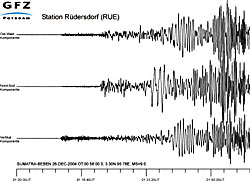
Seismic Activity during the Sumatra earthquake, December 2004
(www.gfz-potsdam.de) |
Recent natural disasters like the Tsunami wave in the Indian Ocean (December 2004) or the earthquake in Pakistan (October 2005) have shown that traditional disaster management and related systems have several drawbacks. The design of existing monitoring networks for earthquake waves reflects the scientific needs, they are high precise and wide meshed. These systems are not suited for Earthquake Early Warning. The methods for detecting earthquakes and predicting their propagation are very time-consuming. Another reason is the availability of the monitoring data. Early Warning System need real-time data of ground movement to derive a warning decision. Traditional systems are not able to provide real-time data, which makes timely warnings impossible. Furthermore traditional solutions often make use of expensive computation and communication hardware (e.g. special sensor hardware, satellite uplinks, etc.), which makes them expensive in purchase and operation.
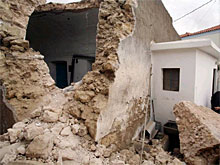
Earthquake damage in Greece, January 2006
(www.espace.ch) |
The goal of our project is to provide a Computing and Communication Technology Portfolio for Earthquake Early Warning Systems. It should allow the deployment of Earthquake Early Warning Systems in different areas with different conditions. For example, an urban area like Istanbul, Turkey, has different characteristics and problems compared to the mountain region in Pakistan. It is desirable to provide building blocks which could be combined by a manufacturer according to the needs of the concrete deployment area. Technologic basis for the project is the Berlin Roofnet, an ad-hoc, wireless, self-organizing, multi-hop mesh network.The functional requirements for an Earthquake Early Warning System can be subdivided into online, real-time monitoring and data processing, early warning, persistent storage of monitoring data and optionally, additional services:
Online, real-time monitoring
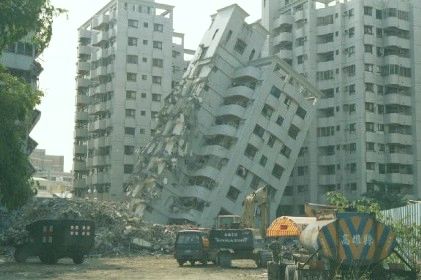
Earthquake damage
(www.cedim.de) |
The Earthquake Early Warning System must provide the monitored data online and in real-time. The constrains online and real-time are crucial prerequisites for the following tasks of data processing and early warning. The system would be useless if the measurement data is not available until the disaster finally happened. These requirements are specific for the application domain of Early Warning Systems and distinct them from monitoring-only systems like traffic or air quality monitoring systems.
In order to enable data exchanged between the sensors, the system itself is connected by a IEEE 802.11 Wireless LAN network. The usage of of-the-shelf IEEE 802.11b/g hardware significantly reduces purchase and operational costs, since the network devices are inexpensive, publicly available and operate in license-free radio frequencies. So it is possible to deploy more sensing elements within the same financial budget. The sensors form a finely meshed monitoring network which highly increases the monitoring density compared to traditional approaches. This allows to use coarse resolving and therefore inexpensive sensor hardware to achieve the equal overall result. The decreased accuracy of a single sensor is compensated by the increased monitoring density.
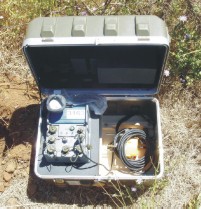
Seismic sensor
(www.gfz-potsdam.de) |
An observation with wireless networks is that the available bandwidth for the single sensor node decreases with increasing network size, because each node has to relay more foreign traffic. One particular challenge is to realize a scalable communication technology able to give certain timing guarantees in consideration of the increased network size.
Furthermore, the monitoring network provides real-time and historical monitoring data for external access through its wireless (and wired, if available) interface. Since both 802.11 Wireless LAN and Ethernet are not well suited for long distance interconnections, because the first has a radio range up to only several kilometers (under optimal conditions). It is very likely the existing infrastructure owned by public vendors (ISPs) is destroyed by the earthquakes because of their centralized nature. Possible solutions for long distance interconnections could be satellite uplinks or GSM connections.
Large networks require high deployment and configuration efforts. So it is desirable to leave these tasks to the network and make it therefore self-organizing. The deployment should be reduced to the physical placement of sensors in the target area. This is done in an unplanned (spontaneous) manner, so no assumptions about the concrete placement of a node is made. The network forms itself without any help of an operator. The self-organization makes it possible for everybody to set up, run and extend such a network, it is not necessary to be an expert on this field.
Monitoring and early warning does not only concern government and sciences, it is also a subject to each individual. For example, a lot of today's households use devices like smoke detectors to get a warning in the case of a fire. So there are a lot of advantages in making the necessary equipment publicly available. Individual people and companies can join the network and will be integrated into the system. The Earthquake Early Warning System should be opportunistic, i.e. it should use all sensor nodes available regardless if they belong to the core network or to individuals. With the help of these additional participants the monitoring quality and accuracy increases. But this means also that the equipment must be affordable and easy to deploy and use. It is also imaginable to provide extra incentives through additional services to promote the public acceptance.
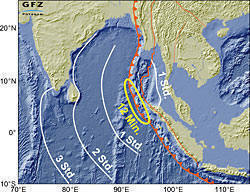
Propagation of the Sumatra Tsunami flood wave, December 2004
(www.gfz-potsdam.de) |
Online, real-time data processing
It is necessary that decisions based on the gathered data are made in time. For example, the timeframe between the first signs of an earthquake and the disaster itself is very small, typically less than one minute. Within this timeframe, the decision whether an earthquake will follow and the supplies (gas, water, electricity, etc.) have to be interrupted has to be made.
The traditional, centralized algorithms for earthquake detection have to be redesigned to support a decentralized data processing and decision finding. Domain-specific constrains have to be taken into account: Constrains in processing time, computing power, memory, storage, networking bandwidth and latency. There is a hard deadline up to which the result must be calculated, so the available processing time is limited. The of-the-shelf hardware has very little computing power and memory compared to traditional systems.
Early Warning
The timeliness is an important point for an Earthquake Early Warning System. There is typically a fixed timeframe in which the decision whether to trigger an alarm must be make. But the same importance comes to dependability and accuracy: Imagine a system giving false alarms and the consequences, e.g. in the case of an earthquake the interruption of all supplies in the affected area. The economic loss due to the standstill would be enormous.
It is important to have an operating communication infrastructure after a disaster had happened. So Early Warning Systems existing in a region hit by an earthquake could provide an alternative communication infrastructure. This means that the system has to be robust enough to overcome the disaster (besides physical destruction) and reorganize itself in an autonomous fashion.
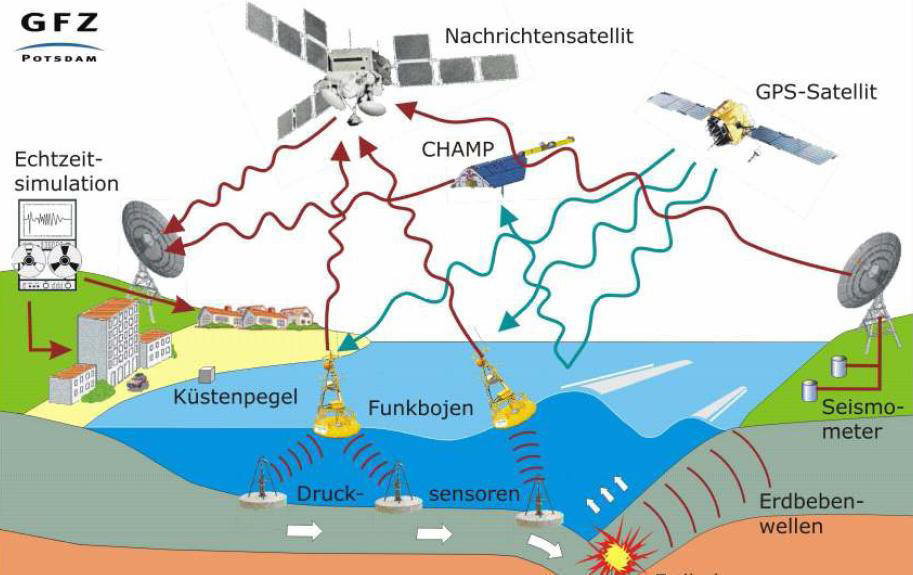
Tsunami Early Warning: A traditional early warning system
(www.gfz-potsdam.de) |
Persistent Storage
The Earthquake Early Warning System provides both real-time and historical monitoring data. On the basis of the real-time data the early warning is realized. The historical data is stored on each sensor node in order to give information about seismic activities over the time. So the ground movement during an earthquake could be reproduced and online shake-maps could be generated.
Additional Services
To further improve cost-effectiveness and provide extra incentives for potential participants, there could be additional services established. For example, several monitoring and early warning systems could be combined to one large system. Furthermore, services like public internet access, email delivery or toll collection for the usage of roads are imaginable. With the usage of such system for multiple purposes the problem of priorities arises. For example, as longs as an early warning system has not detected an alarm, low priority services like public internet access are allowed. But when the first signs of a potential alarm are detected, these services are throttled down or stopped in order to guarantee accurate and timely alarms.
